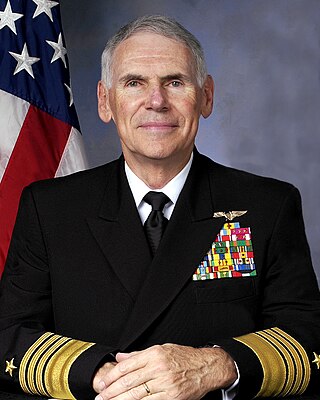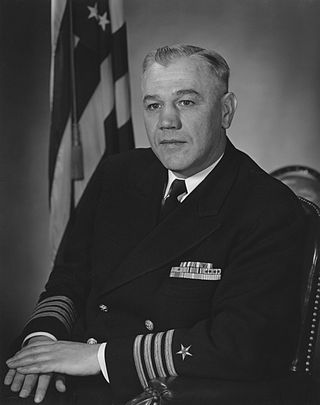
Richard Evelyn Byrd Jr., an American naval officer, was a pioneering American aviator, polar explorer, and organizer of polar logistics. Aircraft flights in which he served as a navigator and expedition leader crossed the Atlantic Ocean, a segment of the Arctic Ocean, and a segment of the Antarctic Plateau. He is also known for discovering Mount Sidley, the largest dormant volcano in Antarctica.

Charles Wilkes was an American naval officer, ship's captain, and explorer. He led the United States Exploring Expedition (1838–1842).

William Joseph Fallon is a retired United States Navy four-star admiral who retired after serving for over 41 years. His last military assignment was as Commander, U.S. Central Command from March 2007 to March 2008. ADM Fallon was the first Navy officer to hold that position. His other four-star assignments include Commander, U.S. Pacific Command from February 2005 to March 2007, Commander, U.S. Fleet Forces Command from October 2003 to February 2005, and 31st Vice Chief of Naval Operations from October 2000 to August 2003. On March 11, 2008, he announced his resignation from CENTCOM and retirement from active duty, citing administrative complications caused in part by an article in Esquire Magazine, which described him as the only thing standing between the Bush Administration and war with Iran.

Edward David Taussig was a decorated Rear Admiral in the United States Navy. He is best remembered for being the officer to claim Wake Island after the Spanish–American War, as well as accepting the physical relinquishment of Guam by its Spanish governor following the Treaty of Paris in which Spain ceded Guam to the United States following nearly 300 years of colonial rule. Taussig briefly served as Governor of Guam. He was the first of a four-generational family of United States Naval Academy graduates including his son, Vice Admiral Joseph K. Taussig (1877–1947), grandson Captain Joseph K. Taussig Jr. (1920–1999), and great-grandson, Captain Joseph K. Taussig USMC (1945–).
Operation Deep Freeze is codename for a series of United States missions to Antarctica, beginning with "Operation Deep Freeze I" in 1955–56, followed by "Operation Deep Freeze II", "Operation Deep Freeze III", and so on.. Given the continuing and constant US presence in Antarctica since that date, "Operation Deep Freeze" has come to be used as a general term for US operations in that continent, and in particular for the regular missions to resupply US Antarctic bases, coordinated by the United States military. Task Force 199 was involved.

Rear Admiral Gerald L. Ketchum was a career officer in the United States Navy. He served during World War II and the Korean War. He was a recipient of the Silver Star and also participated in four expeditions to Antarctica.

Ralph Andrew Ofstie was a Vice Admiral in the United States Navy, an escort carrier commander in World War II, Deputy Chief of Naval Operations (Air), and Commander of the U.S. Sixth Fleet. He was born in Eau Claire, Wisconsin and his hometown was Everett, Washington.

George John Dufek was an American naval officer, naval aviator, and polar expert. He served in World War II and the Korean War and in the 1940s and 1950s spent much of his career in the Antarctic, first with Admiral Byrd and later as supervisor of U.S. programs in the South Polar regions. Rear Admiral Dufek was the director of the Mariners' Museum in Newport News, Virginia after his retirement from the Navy in 1959.
Mount Acton is at 3015 m, the dominant peak of the west ridge of the Welch Mountains in Palmer Land, West Antarctica. Argentina, Chile and United Kingdom claim this area. Mapped by United States Geological Survey (USGS) in 1974. Named by Advisory Committee on Antarctic Names (US-ACAN) for Commander William Acton, U.S. Navy, operations officer on the staff of the commander, U.S. Naval Support Force, Antarctica, 1967–68, and executive officer, 1968–69.
The McCuddin Mountains are a small cluster of mountains in Antarctica consisting mainly of two large mountains, Mount Flint and Mount Petras, along with several scattered peaks and nunataks. Located in Marie Byrd Land, 64 km (40 mi) east of the Ames Range, with Wallace Rock as its southeast extremity.

John Howard Hoover was a United States Navy admiral who held several flag commands during World War II most notably those in the Central Pacific under Chester W. Nimitz. Hoover became one of Nimitz's trusted if little known admirals of the Pacific war.

Admiral Sir William Gerrard Andrewes was a Royal Navy officer who served in World War I and World War II, commanded the British and Commonwealth Naval Forces and Task Force 91 for the Inchon Landing during the Korean War, and went on to command of the America and West Indies Squadron and served as Deputy Supreme Allied Commander, Atlantic.
Sallee Snowfield is a large snowfield between Dufek Massif and northern Forrestal Range in the Pensacola Mountains in Antarctica. Mapped by United States Geological Survey (USGS) from surveys and U.S. Navy air photos, 1956–66. Named by Advisory Committee on Antarctic Names (US-ACAN) for Lieutenant Commander Ralph W. Sallee, Asst. Meteorological Officer on the staff of the Commander, U.S. Naval Support Force, Antarctica, in 1967 and 1968.

Air Development Squadron Six was a United States Navy Air Development Squadron based at McMurdo Station, Antarctica. Established at Naval Air Station Patuxent River, Maryland on 17 January 1955, the squadron's mission was to conduct operations in support of Operation Deep Freeze, the operational component of the United States Antarctic Program.

Bertram Joseph Rodgers was a highly decorated vice admiral in the United States Navy during World War II. He received his Navy Cross as captain of USS Salt Lake City in the battle of the Komandorski islands, during the Aleutian Islands Campaign.

Major General William M. Lenaers is a retired general officer in the United States Army and served as Commanding General, U.S. Army Tank-automotive and Armaments Command in Warren, Michigan from 2004 to 2008. Prior to this assignment, he served as the 32nd Chief of Ordnance and Commandant of the U.S. Army Ordnance School at Aberdeen Proving Grounds, Maryland.

Hugh Hilton Goodwin was a decorated officer in the United States Navy with the rank of Vice Admiral. A veteran of both World Wars, he commanded escort carrier USS Gambier Bay (CVE-73) during the Mariana Islands campaign. Goodwin then served consecutively as Chief of Staff, Carrier Strike Group 6 and as Air Officer, Philippine Sea Frontier and participated in the Philippines campaign in the later part of the War.

Robert Dale, known as Bob Dale, was an American aircraft pilot for the United States Navy from 1942 to 1966; and a pilot for the National Science Foundation from 1967 to 1975. For his efforts as a pilot in Antarctica as Lieutenant Commander, USN, and part of the Antarctic Operation Deep Freeze (1959–1960), Dale Glacier was named after him by the Advisory Committee on Antarctic Names (US-ACAN) in 1963.













